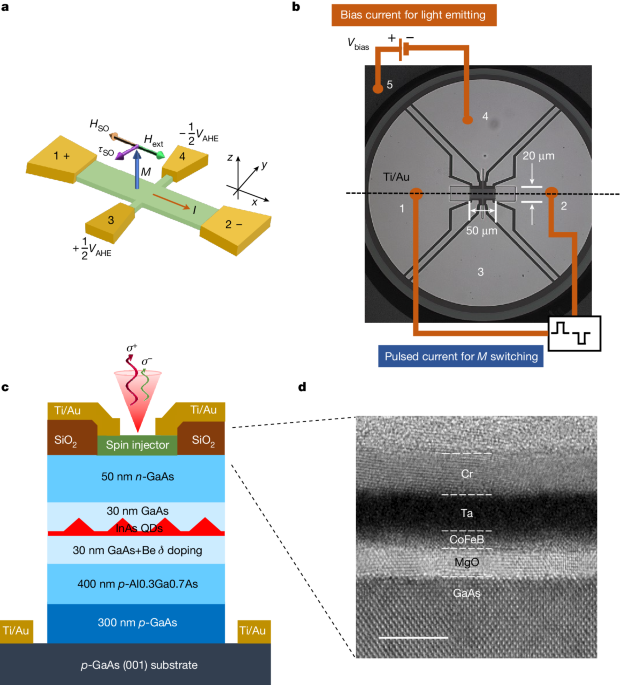Controlling Circular Polarization of Light with Electrically Controlled Magnetization
מושגי ליבה
Controlling circular polarization of light through electrically controlled magnetization enables seamless integration of information transfer, processing, and storage.
תקציר
The content discusses the significance of modulating circular polarization of emitted light through electrically controlled magnetization. It highlights the transfer of angular momentum between photons, electrons, and ferromagnets to achieve this modulation. The use of spin-orbit torque to generate a spin current for magnetization switching is explained, emphasizing the control of spin orientation in semiconductors. The results showcase advancements in ultrafast modulation of circular polarization and spin injection for future information and communication technologies, including space-light data transfer and quantum information processing.
Controlling the helicity of light by electrical magnetization switching - Nature
סטטיסטיקה
Controlling the intensity of emitted light and charge current is crucial for transferring and processing information.
Magnetic random-access memories are implemented using the spin of the carrier and associated magnetization in ferromagnets.
Circular polarization of emitted light can be modulated by electrically controlled magnetization.
Spin-orbit torque enables a charge current to generate a spin current for electrically switching magnetization.
Transfer of angular momentum from electron spin to photon controls circular polarization of emitted light.
ציטוטים
"The missing link between the respective disciplines of photonics, electronics, and spintronics is to modulate the circular polarization of the emitted light, rather than its intensity, by electrically controlled magnetization."
"Our results provide substantial advances towards electrically controlled ultrafast modulation of circular polarization and spin injection with magnetization dynamics for the next-generation information and communication technology."
תובנות מפתח מזוקקות מ:
by Pambiang Abe... ב- www.nature.com 03-27-2024
https://www.nature.com/articles/s41586-024-07125-5
שאלות מעמיקות
How can the integration of circular polarization modulation enhance current information processing technologies
The integration of circular polarization modulation can significantly enhance current information processing technologies by enabling the manipulation of the spin orientation of injected carriers into semiconductors. This modulation allows for the transfer of angular momentum from the electron spin to photons, thereby controlling the circular polarization of the emitted light. By electrically controlling magnetization to switch the spin orientation of carriers, the circular polarization of light can be modulated in light-emitting diodes. This advancement opens up new possibilities for seamlessly integrating information transfer, processing, and storage. It also paves the way for ultrafast modulation of circular polarization and spin injection, which are crucial for next-generation information and communication technologies, including space-light data transfer.
What potential challenges or limitations might arise in implementing electrically controlled magnetization for circular polarization modulation
Despite the promising potential of electrically controlled magnetization for circular polarization modulation, there are several challenges and limitations that may arise during implementation. One challenge is the need for efficient spin-orbit torque mechanisms to generate a spin current that can switch the magnetization electrically. Ensuring the reliability and stability of this process at room temperature and zero applied magnetic field is crucial for practical applications. Additionally, the scalability of the technology to smaller structures or two-dimensional materials may pose challenges in maintaining the desired functionality and performance. Furthermore, addressing issues related to power consumption, heat dissipation, and material compatibility will be essential for the successful implementation of electrically controlled magnetization for circular polarization modulation.
How might advancements in spin-controlled single-photon sources impact quantum information processing in the future
Advancements in spin-controlled single-photon sources have the potential to revolutionize quantum information processing in the future. By leveraging spin-dependent time-resolved spectroscopies and utilizing single-photon sources with controlled spin properties, researchers can explore new avenues for quantum communication and computation. These advancements could lead to the development of more efficient and secure quantum communication protocols, as well as the realization of quantum networks with enhanced capabilities. Spin-controlled single-photon sources offer the possibility of generating and manipulating individual photons with specific spin states, enabling precise control over quantum information processing tasks. Overall, these advancements hold great promise for the future of quantum information processing and could drive significant progress in the field.
0
